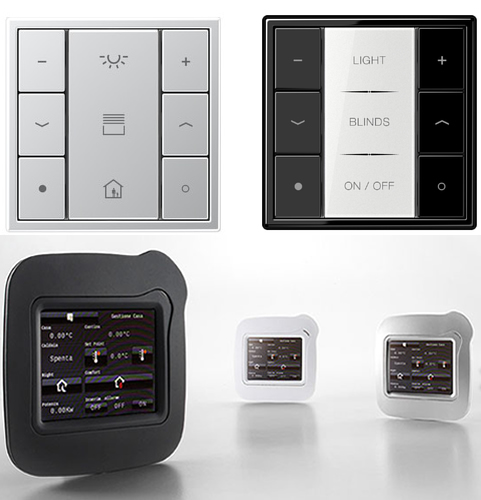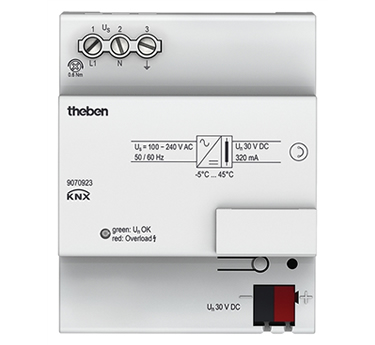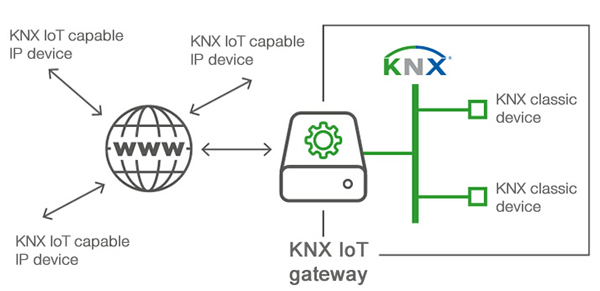 By Vassilios Lourdas, KNX Association.
By Vassilios Lourdas, KNX Association.
KNX is the leading global standard for home and building control and is complied with by numerous manufacturers. This means that you can mix and match products from different companies, and they will all work together. But what is the technology behind KNX, and what is the future of its only commissioning tool, ETS? The following short overview summarises some major points.
KNX system architecture
KNX is based on a bus technology. This means that all physical devices in a KNX system use the same transmission method and are able to exchange data via a common bus network. Access to the bus network is clearly regulated using the ‘bus access’ method.

An important feature of the KNX bus system is its decentralised structure. Every KNX device has its own microprocessor, which means that there is no need for a central control unit, because the ‘intelligence’ of the system is spread across all of its devices. Centralised units are possible, but these tend to be used for very specialised applications.
A major advantage of KNX’s decentralised structure is that, if one device fails, the others continue to function, since the configuration is done individually, at device level. Only those applications dependent on the failed device will be interrupted.
Generally, in a KNX system, devices fall into three categories:
• Sensors.
• Actuators.
• System devices.
Sensors are devices that detect events or actions in the building. Sensors can include presence detectors, push buttons, touchpanels, apps for mobile devices etc. Events or actions could include things such as someone pressing a button, someone moving, a temperature falling above or below a set value, etc. Sensors convert events into telegrams (data packets), and send them along the bus cable.


Actuators are devices that receive these telegrams and convert the commands embedded in them, into actions. They are basically switches and dimmers for lighting, shading, heating etc. Sensors issue commands, while actuators receive them.

System devices are products such as power supplies, programming interfaces, couplers, etc.

Creating the KNX bus
KNX has been designed to be very flexible, so that it can be installed in all kinds of building and environment. If a new building is being created, it would be usual to create the KNX bus using a cable, but for retrofit in existing buildings, re-wiring is not always possible. KNX offers a number of ways to create the bus:
• KNX Twisted Pair (KNX TP) – communication via a twisted pair data cable (bus cable).
• KNX Powerline (KNX PL) – uses the existing mains network.
• KNX Radio Frequency (KNX RF) – wireless communication via radio signal.
• KNX IP – communication via Ethernet.

Programming the KNX system
A KNX system can be programmed by one of the following two modes:
• S-Mode : the majority of KNX products today are designed to be configured and commissioned using S-Mode. To do this, a special software, namely ETS Professional, is required. This is Windows-based software that runs on a PC.
• E-Mode: products designed for E-mode are configured not using a PC, but a handheld unit, push buttons, or other means. This configuration method is suitable for electricians with a basic knowledge of bus technology, but no software skills. S-Mode devices can, however, always be added to an E-Mode installation at a later stage.
ETS – the key success factor of the KNX system
ETS Professional is manufacturer-independent software that can be used to configure and commission S-Mode devices, as well as plan, design, commission and diagnose entire KNX installations with KNX-certified products. ETS Professional has been developed and marketed for more than 25 years by KNX Association in Brussels, in coordination with the respective KNX manufacturer working groups, which take care of the integration of KNX system extensions such as KNX Secure (encrypted KNX communications and data) into the standard software functionality, as well as usability aspects and software support.
ETS Professional is the beauty, but also the heart of KNX technology. System integrators can use it to connect certified products from more than 450 different manufacturers and from different application domains to form a single installation. Moreover, there is no need to have any computer programming knowledge in order to start with KNX, since ETS Professional provides all that is needed to set everything up via a modern and user-friendly environment. It has drag & drop functions as well as the possibility to add apps from the KNX Store.
ETS today
ETS Professional is currently in its fifth generation, i.e. ETS5 Professional. One of the main features of the new version, that sets KNX apart from any other competitive technology, is support for KNX Secure (uses encryption), as well as KNX RF S-Mode devices and Smart Linking. Smart Linking is a new initiative within ETS that allows devices to be linked on ‘channel’ level (a feature that is already available in ETS Professional today via the Building View, but which will, of course, be further developed and improved).
The current version of ETS is 5.6.6, which added many enhancements to the user interface as well as integration of new system aspects. It can be downloaded via the Downloads section of MyKNX.
ETS challenges
The main challenge of ETS is, and always will be, backwards compatibility. KNX devices have a lifecycle of at least 15 years, which is extremely long in the world of software. Currently, this means that ETS will still support KNX devices that require plug-ins and DCAs (a DCA is an additional way to configure KNX devices within ETS) for another 15-20 years.
Another challenge is to support products as they become ever more complex. These include devices supporting encryption (KNX Secure); devices with a large number of individual channels such as 24-fold switch actuators that require modular applications (codename MAP); all kinds of advanced features based on advanced bus services (such as Group Object diagnostics); and all possible combinations thereof.
The diagram below shows the principle of how we will handle large KNX applications in the future and what the benefits are.

ETS short-term features
We are planning to improve problem-handling in the field, in a dynamic, online way, which means that once a problem with a specific device is identified, a proper handling method (message, workaround or even solution) can be used for any installed ETS – a concept similar to ETS updates.
As devices and installations become ever more complex, so too do ETS diagnostic functions. Our challenge is to make sure that the ETS user, despite increased complexity, remains in a comfortable position.
ETS will in the future be part of the installation rather than a project file kept by the installer; it will be integrated because of its online services. This is already the case for ETS Inside which is aimed at integrators involved with less complex projects, where the project remains with the installation and can be modified, in a limited way, by the end user.

This concept will also be the basis for KNX IoT, but make no mistake – KNX is and always will be a decentralised system.

ETS mid-term features
There is also the aim to make ETS operating-system-independent, i.e. we want ETS to become available for any platform and appropriate to the ‘profile’ of the ETS user. For example, there will always be the expert using ETS on a Windows laptop, there will be scientists working with it on Linux, and end users dabbling with it on tablets and/or smartphones.
Conclusion
The increased challenges of building control for smart homes and commercial buildings require solving complex installation challenges in order to meet customers’ demands. Flexibility and ease of use on the customers’ side, mean higher complexity on the tools’ side. The KNX system and its ETS programming tools are more than prepared to meet these challenges.
If you would like to learn more about programming KNX systems using ETS, there are plenty of online courses, including the ETS e-Campus as well as training centres around the world.
Vassilios Lourdas is a Tools Engineer for KNX Association.












